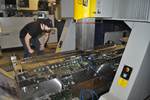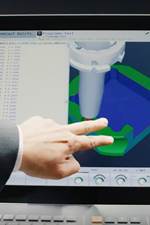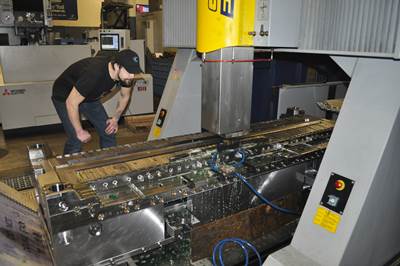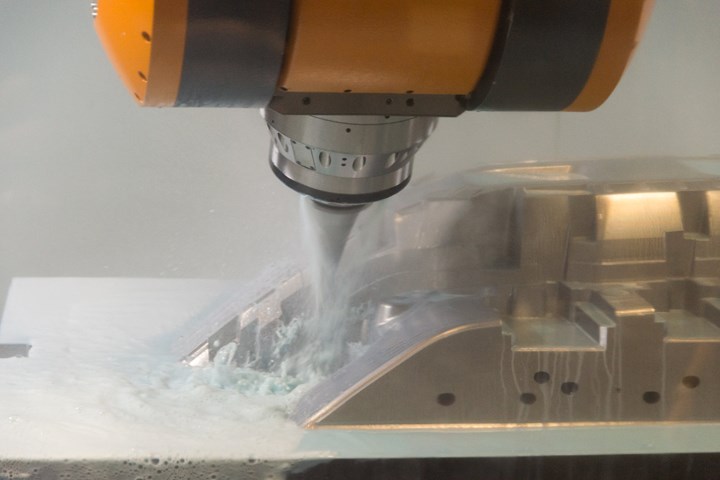
An APEC five-axis machine with Heidenhain control is shown finish cutting a mold core. Photo Credit: Cavalier Tool & Manufacturing Ltd.
Cavalier Tool & Manufacturing Ltd. is a 46-year-old full-service moldmaker producing over 200 high-precision, medium-to-large injection, structural foam, multi-shot injection, gas-assist and injection/compression tools annually. The company offers feasibility, design and product development; moldfilling analyses; mold manufacture, modification and repair; and startup and try-out services, including small production runs. Company management has made the strategic decision not to allow any single industry to dominate their business, enabling Cavalier to more easily weather the cyclical nature of industries like automotive by diversifying its customer base to include commercial truck, recreational vehicle, agricultural equipment, medical and consumer markets.
Despite the pandemic, much has changed at the company over the past few years. Cavalier has often sent overflow design work to India, but has now formally set up two offices in Chennai and one in Lucknow. Last year, Cavalier acquired nearby Mold Services International, a company to which Cavalier had often subcontracted. The acquisition expanded Cavalier’s injection moldmaking capacity as well as bring on new compression moldmaking capabilities at what is now Cavalier Plant #2.
And last summer, they acquired the building next door, which will shortly become Cavalier Plant #3 after being repurposed. The building will accommodate a new component cell (including three five-axis milling machines, a robot, and wire and sinker EDMs to produce small items like lifters, slides and inserts) and a large finishing machine (a 3- x 5-meter, rise and fall bridge machine with three interchangeable heads that can move up or down to adjust for workpiece height) with additional room to grow.
The continuing expansion means that Cavalier’s team has increased to 235 people and the company’s manufacturing footprint has grown to 114,000 square feet/10,591 square meters, with an additional 11,700 square feet/1,087 square meters to be added as soon as Plant #3 comes online.
Why does Cavalier keep ordering new machines with Heidenhain controls? “They help ensure that we can cut more accurately, produce better quality, and achieve faster turnaround, which is what has allowed us to keep expanding.”
Modernizing and Upgrading
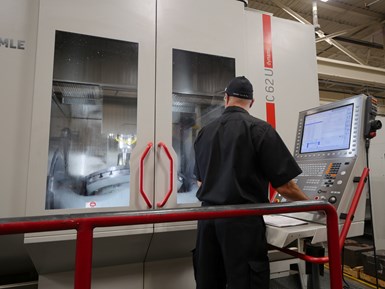
Here, a Cavalier operator preps a Hermle CNC machine to finish cutting a workpiece using a Heidenhain TNC 640 controller. Photo Credit: Cavalier Tool & Manufacturing Ltd.
Cavalier claims to be 20-30% faster than its global competitors and credits its leadership position to continuously investing in what company president, Brian Bendig calls “the three pillars that make our company strong: people, process and equipment.” As such, for the last dozen years, Bendig has invested significant time and effort researching the industry’s best technologies, benchmarking competitive systems, purchasing equipment and then ensuring his team is trained and cross-trained so each investment is used to its max. “Our operating philosophy is to understand what needs to be done, do it right the first time and do it better tomorrow,” Bendig adds. “We don’t aspire to be the biggest mold shop, but we do aim to be the best.”
As the company began replacing older machines with high-speed, high-precision, multiaxis CNC equipment, one thing the team noticed was that the premier machine builders tended to favor controllers from just two companies, and that experienced operators tended to prefer one system for its intuitive interface, ease of use and accuracy: Heidenhain (from Dr. Johannes Heidenhain GmbH).
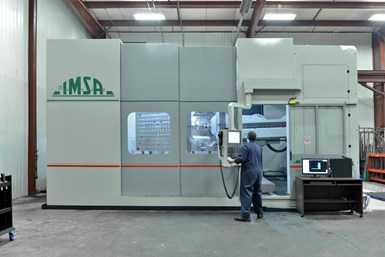
This seven-axis IMSA gundrill was Cavalier’s first piece of equipment that sported Heidenhain control (TNC 530). The combo increased productivity so much versus the three-axis gundrill it replaced that the company ordered a second identical machine and controller a year later. Photo Credit: Cavalier Tool & Manufacturing Ltd.
“Nine or 10 years ago, we bought a seven-axis IMSA gundrill [from IMSA Srl] to drill our water lines and it came equipped with a Heidenhain controller—our first,” explains Rob Wilson, Cavalier maintenance manager. “The machine our IMSA replaced could only drill in three axes, and wasn’t automated, so anytime a job called for a tipped setup, there was always a lot of manual labor involved, which slowed down production.”
With the new gundrill and Heidenhain controller, Wilson says the team found they could suddenly design a little differently, putting angled water lines in because setups were simple, and the work was very accurate. The productivity boost from the IMSA/Heidenhain combo led, a year later, to the purchase of a second IMSA with the same features and controller. As time went on, and Bendig ordered additional high-speed, multiaxis equipment, he requested Heidenhain controllers.
“Originally, we had a broad mix of both machines and controllers, and every system required a slightly different approach,” adds Tim Galbraith, Cavalier sales manager. “As we began upgrading our equipment and standardizing our controls—roughly half of them are now Heidenhain TNC 530s or TNC 640s—setup times for our operators got simpler and faster and post-process output became more streamlined. Also, when you have one post-processor working across your entire process line, you gain the ability to put a job on any machine offering that function that opens up first, giving us a lot of scheduling flexibility. All this has helped us reduce the time it takes to produce quality tools so we can stay globally competitive.”
Metrology Masters
In the late 1800s, Heidenhain began life producing embroidery technology. Later, the company started etching glass, and by the 1950s had patented a process for making extremely accurate (±5 microns spacing) etched glass scales to control the position of tables on machine tools—which marked the company’s entrance into the metrology field. By the late 1970s, Heidenhain glass scales and angle encoders were being used to control contour in three axes on the first CNC machines. As the company’s experience and skills with controlling measurements grew, it added motion-control motors, drives and controllers, eventually producing entire motion-control systems. Today, Heidenhain technology is used in precision markets ranging from machine tool to automation, robotics, electronics, medical, drive systems, structural health monitoring, elevators and the printing industry.
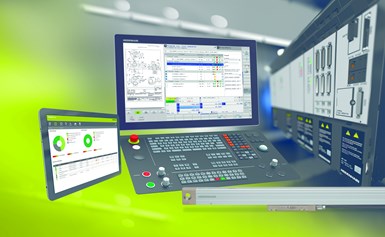
This composite image shows a Heidenhain TNC 640 controller (middle) along with a linear scale (bottom) and Heidenhain StateMonitor software on the tablet (left).
Photo Credit: Dr. Johannes Heidenhain GmbH
“There are a lot of CNC control systems in the market, and all of them are good, but the biggest difference between Heidenhain and its competitors is that our systems were born in the shops of mold and die makers—companies whose business is high mix/low volume—rather than coming out of general manufacturing—which tends to be high volume/low mix,” recalls Gisbert Ledvon, director –business development machine tool at Heidenhain Corp. “We kept going back to those toolmakers and asking them to tell us how to make the perfect controls, so what you see in our systems today incorporates the wants and needs of actual tool and die makers.”
Asked what benefit a shop gains by standardizing CNC controls rather than CNC machines, Ledvon adds, “When you standardize your operation based on machine brand, you’re locking yourself into one company’s technology. Then, later on, you might find that you need a much bigger or much smaller machine than that company makes, so you end up restricting yourself. On the other hand, if you choose to standardize your motion-control systems as Cavalier has done, not only do you gain very accurate machine motion but you also retain the flexibility to pick and choose the machine that best meets your needs.”
“If you choose to standardize your motion-control systems as Cavalier has done, not only do you gain very accurate machine motion but you also retain the flexibility to pick and choose the machine that best meets your needs.”
Helping Customers Remain Competitive While Reshoring Jobs
An interesting multi-tool package that Cavalier competed for highlights just how important it is for machines and controls to be able to hold very tight tolerances. The customer—a consumer products company—needed multicavity injection molds to produce nursery trays, which hold plastic pots in which young plants are grown before being shipped to garden centers around North America. Typically, these plastic trays are produced offshore and shipped in via containers ships. To make the trays cost-competitive to produce in North America, they had to be produced in very short injection cycles and with very thin walls.
The tray program was so successful that Cavalier was subsequently asked to quote tooling to produce the pots that sit in the trays. To qualify as a supplier for that job, the Cavalier team had to prove they were capable of holding the tight tolerances required of the job by passing an interesting cutting test.
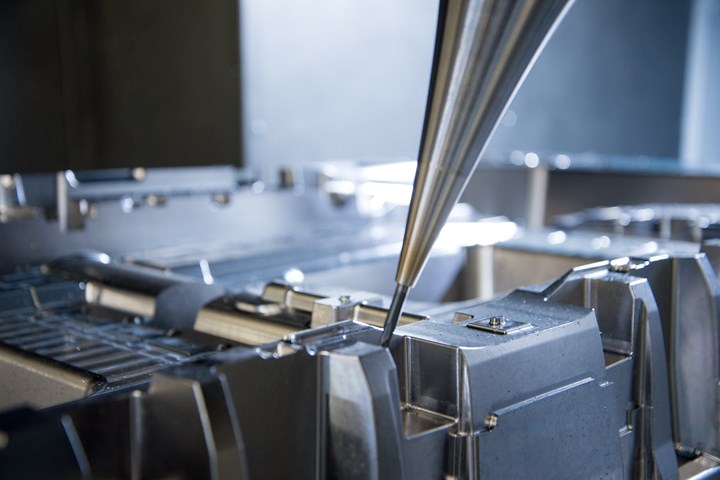
A five-axis Huron bridge machine begins finish cutting a workpiece. Typically outfitted with a different control system, Cavalier president Brian Bendig conditioned the purchase of two identical machines on having them switched over to Heidenhain control. Photo Credit: Cavalier Tool & Manufacturing Ltd.
“These tools were intended to be used in very high-volume manufacturing, and we had to hold tolerances of half-a-thousandth,” recalls Wilson. “Because pot walls were designed to be less than 1-millimeter (0.04-inch) thick, every cavity had to be perfect and fill evenly.” By using tight-tolerance, cooling-optimized injection molds produced by Cavalier, the customer successfully reshored the job.
“We were asked to make a domed core—it resembled a large, upside-down metal bowl—that was dimensionally inspected for surface finish, cutting accuracy and concentricity,” explains Galbraith. “There were very tight tolerance requirements for all aspects of the test piece and we passed them all. We credit those Heidenhain controls with helping us hold the tolerances needed to get both jobs.”
Kinematic Control
“With older machines that aren’t equipped with Heidenhain controls, running kinematic checks used to be time consuming, so operators were often reluctant to run them, which meant you could spend more time operating a machine that wasn’t accurate,” adds Wilson. “However, one of the biggest advantages of Heidenhain controls is that the systems are really user-friendly and feature automatic kinematic control cycles. Once operators see how easy it is to run kinematic checks, they do so on a regular basis and that ensures the geometry of each machine stays very accurate.”
Why does Cavalier keep ordering new machines with Heidenhain controls? “They help ensure that we can cut more accurately, produce better quality and achieve faster turnaround, which is what has allowed us to keep expanding,” concludes Galbraith. “People come through our plant and are amazed at what we’re able to do. One of them told me, ‘You don’t know how cool you are, because you do it every day.’ With high-precision CNC and EDM equipment and Heidenhain controllers, I guess it really has become an old hat.”
Related Content
How to Eliminate Chatter
Here are techniques commonly used to combat chatter and guidelines to establish a foundation for optimizing the moldmaking process.
Read MoreSolving Mold Alignment Problems with the Right Alignment Lock
Correct alignment lock selection can reduce maintenance costs and molding downtime, as well as increase part quality over the mold’s entire life.
Read MoreHow to Produce More Accurate Molds and Reduce Rework
Patented micro-milling process for manufacturing steel plate flat and parallel helps mold builders shorten mold build times and increase accuracy.
Read MoreRead Next
Five-Axis Hard Milling Improves Electrode Accuracy
Fully automated, high-speed hard milling centers saved moldmaker time, money, handwork, allowed wider-range of EDM burns to be achieved.
Read MoreMMT Chats: The Cavalier Tool Army Takes on COVID-19
MoldMaking Technology Editorial Director Christina Fuges chats with Brian Bendig, Tim Galbraith and Brenda Quint of Cavalier Tool & Manufacturing about what it took to take on a hand sanitizer dispenser mold project to help fight COVID-19, as well as the impact of the virus on its business and people.
Read MoreSix CNC Control Features for Moldmakers
A CNC control should have features to automatically smooth the axis movements or allow the operator to set tolerance limits manually.
Read More

.jpg;width=70;height=70;mode=crop)
